Childhood Immunization Coverage in India
VerifiedAdded on 2020/03/16
|17
|4975
|116
AI Summary
This assignment delves into the complexities of achieving optimal childhood immunization coverage in India. It requires a critical analysis of various research papers focusing on specific states like Maharashtra and Bihar, highlighting the barriers faced by rural communities and underprivileged urban areas. The task involves assessing the applicability of existing interventions and exploring strategies to address inequities in immunization access and uptake.
Contribute Materials
Your contribution can guide someone’s learning journey. Share your
documents today.
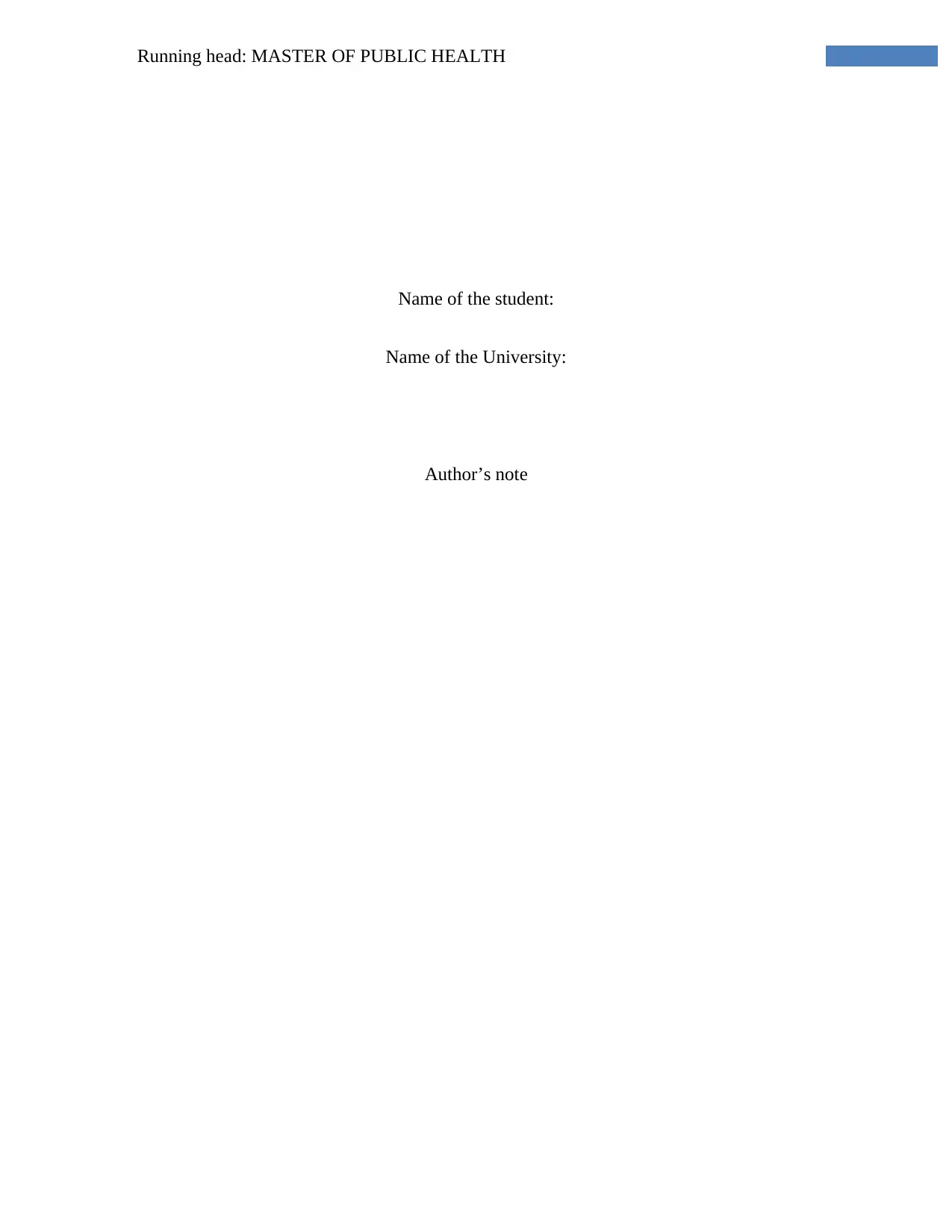
Running head: MASTER OF PUBLIC HEALTH
Name of the student:
Name of the University:
Author’s note
Name of the student:
Name of the University:
Author’s note
Secure Best Marks with AI Grader
Need help grading? Try our AI Grader for instant feedback on your assignments.
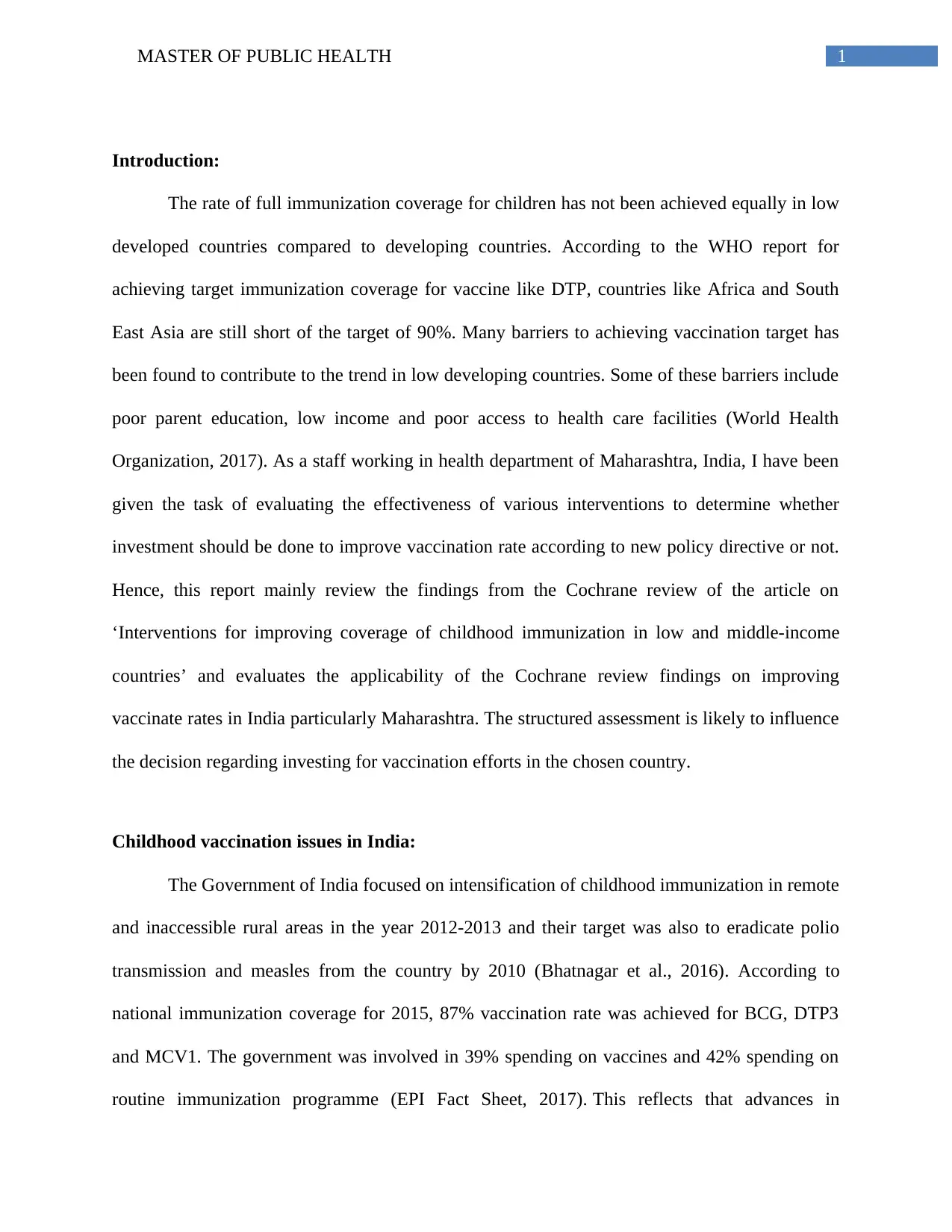
1MASTER OF PUBLIC HEALTH
Introduction:
The rate of full immunization coverage for children has not been achieved equally in low
developed countries compared to developing countries. According to the WHO report for
achieving target immunization coverage for vaccine like DTP, countries like Africa and South
East Asia are still short of the target of 90%. Many barriers to achieving vaccination target has
been found to contribute to the trend in low developing countries. Some of these barriers include
poor parent education, low income and poor access to health care facilities (World Health
Organization, 2017). As a staff working in health department of Maharashtra, India, I have been
given the task of evaluating the effectiveness of various interventions to determine whether
investment should be done to improve vaccination rate according to new policy directive or not.
Hence, this report mainly review the findings from the Cochrane review of the article on
‘Interventions for improving coverage of childhood immunization in low and middle-income
countries’ and evaluates the applicability of the Cochrane review findings on improving
vaccinate rates in India particularly Maharashtra. The structured assessment is likely to influence
the decision regarding investing for vaccination efforts in the chosen country.
Childhood vaccination issues in India:
The Government of India focused on intensification of childhood immunization in remote
and inaccessible rural areas in the year 2012-2013 and their target was also to eradicate polio
transmission and measles from the country by 2010 (Bhatnagar et al., 2016). According to
national immunization coverage for 2015, 87% vaccination rate was achieved for BCG, DTP3
and MCV1. The government was involved in 39% spending on vaccines and 42% spending on
routine immunization programme (EPI Fact Sheet, 2017). This reflects that advances in
Introduction:
The rate of full immunization coverage for children has not been achieved equally in low
developed countries compared to developing countries. According to the WHO report for
achieving target immunization coverage for vaccine like DTP, countries like Africa and South
East Asia are still short of the target of 90%. Many barriers to achieving vaccination target has
been found to contribute to the trend in low developing countries. Some of these barriers include
poor parent education, low income and poor access to health care facilities (World Health
Organization, 2017). As a staff working in health department of Maharashtra, India, I have been
given the task of evaluating the effectiveness of various interventions to determine whether
investment should be done to improve vaccination rate according to new policy directive or not.
Hence, this report mainly review the findings from the Cochrane review of the article on
‘Interventions for improving coverage of childhood immunization in low and middle-income
countries’ and evaluates the applicability of the Cochrane review findings on improving
vaccinate rates in India particularly Maharashtra. The structured assessment is likely to influence
the decision regarding investing for vaccination efforts in the chosen country.
Childhood vaccination issues in India:
The Government of India focused on intensification of childhood immunization in remote
and inaccessible rural areas in the year 2012-2013 and their target was also to eradicate polio
transmission and measles from the country by 2010 (Bhatnagar et al., 2016). According to
national immunization coverage for 2015, 87% vaccination rate was achieved for BCG, DTP3
and MCV1. The government was involved in 39% spending on vaccines and 42% spending on
routine immunization programme (EPI Fact Sheet, 2017). This reflects that advances in
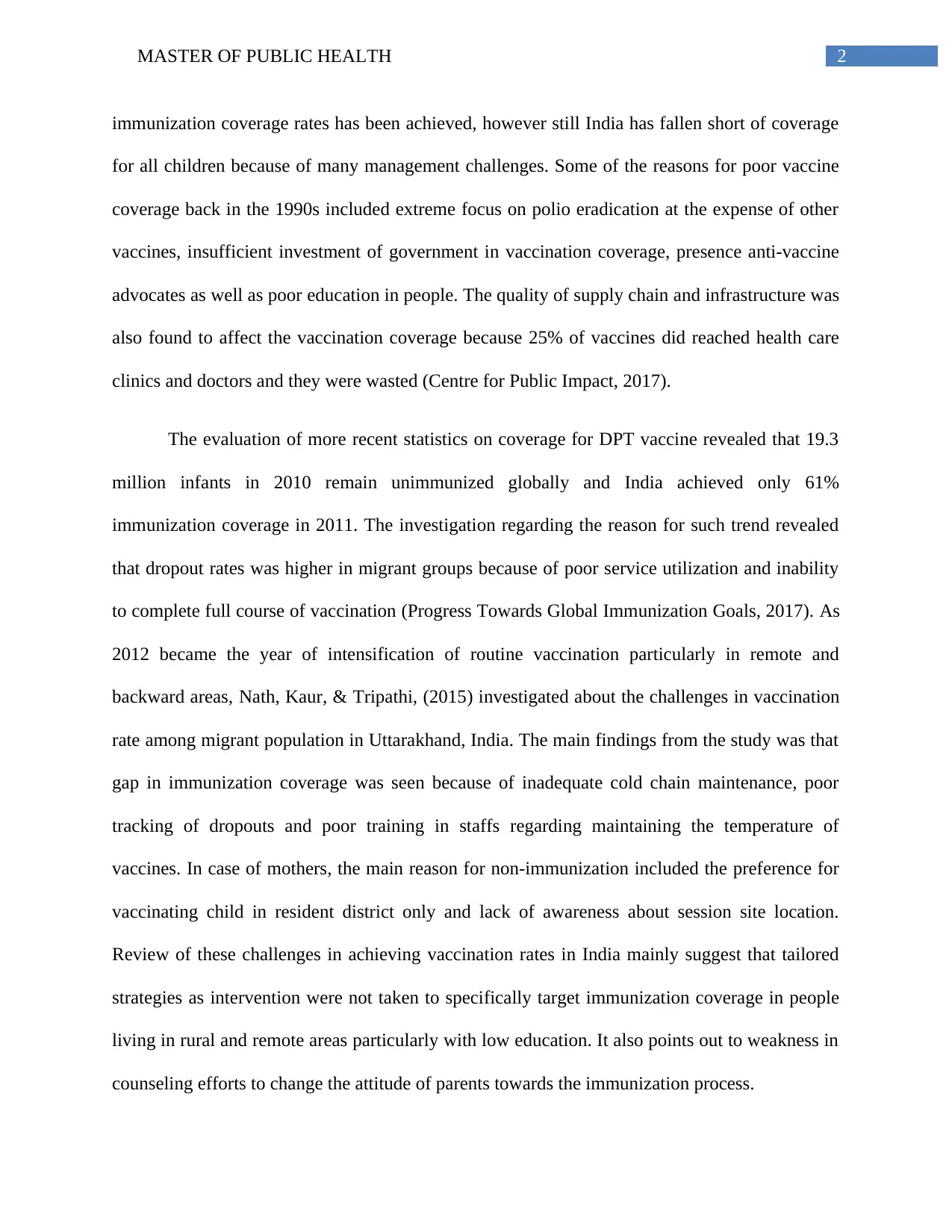
2MASTER OF PUBLIC HEALTH
immunization coverage rates has been achieved, however still India has fallen short of coverage
for all children because of many management challenges. Some of the reasons for poor vaccine
coverage back in the 1990s included extreme focus on polio eradication at the expense of other
vaccines, insufficient investment of government in vaccination coverage, presence anti-vaccine
advocates as well as poor education in people. The quality of supply chain and infrastructure was
also found to affect the vaccination coverage because 25% of vaccines did reached health care
clinics and doctors and they were wasted (Centre for Public Impact, 2017).
The evaluation of more recent statistics on coverage for DPT vaccine revealed that 19.3
million infants in 2010 remain unimmunized globally and India achieved only 61%
immunization coverage in 2011. The investigation regarding the reason for such trend revealed
that dropout rates was higher in migrant groups because of poor service utilization and inability
to complete full course of vaccination (Progress Towards Global Immunization Goals, 2017). As
2012 became the year of intensification of routine vaccination particularly in remote and
backward areas, Nath, Kaur, & Tripathi, (2015) investigated about the challenges in vaccination
rate among migrant population in Uttarakhand, India. The main findings from the study was that
gap in immunization coverage was seen because of inadequate cold chain maintenance, poor
tracking of dropouts and poor training in staffs regarding maintaining the temperature of
vaccines. In case of mothers, the main reason for non-immunization included the preference for
vaccinating child in resident district only and lack of awareness about session site location.
Review of these challenges in achieving vaccination rates in India mainly suggest that tailored
strategies as intervention were not taken to specifically target immunization coverage in people
living in rural and remote areas particularly with low education. It also points out to weakness in
counseling efforts to change the attitude of parents towards the immunization process.
immunization coverage rates has been achieved, however still India has fallen short of coverage
for all children because of many management challenges. Some of the reasons for poor vaccine
coverage back in the 1990s included extreme focus on polio eradication at the expense of other
vaccines, insufficient investment of government in vaccination coverage, presence anti-vaccine
advocates as well as poor education in people. The quality of supply chain and infrastructure was
also found to affect the vaccination coverage because 25% of vaccines did reached health care
clinics and doctors and they were wasted (Centre for Public Impact, 2017).
The evaluation of more recent statistics on coverage for DPT vaccine revealed that 19.3
million infants in 2010 remain unimmunized globally and India achieved only 61%
immunization coverage in 2011. The investigation regarding the reason for such trend revealed
that dropout rates was higher in migrant groups because of poor service utilization and inability
to complete full course of vaccination (Progress Towards Global Immunization Goals, 2017). As
2012 became the year of intensification of routine vaccination particularly in remote and
backward areas, Nath, Kaur, & Tripathi, (2015) investigated about the challenges in vaccination
rate among migrant population in Uttarakhand, India. The main findings from the study was that
gap in immunization coverage was seen because of inadequate cold chain maintenance, poor
tracking of dropouts and poor training in staffs regarding maintaining the temperature of
vaccines. In case of mothers, the main reason for non-immunization included the preference for
vaccinating child in resident district only and lack of awareness about session site location.
Review of these challenges in achieving vaccination rates in India mainly suggest that tailored
strategies as intervention were not taken to specifically target immunization coverage in people
living in rural and remote areas particularly with low education. It also points out to weakness in
counseling efforts to change the attitude of parents towards the immunization process.
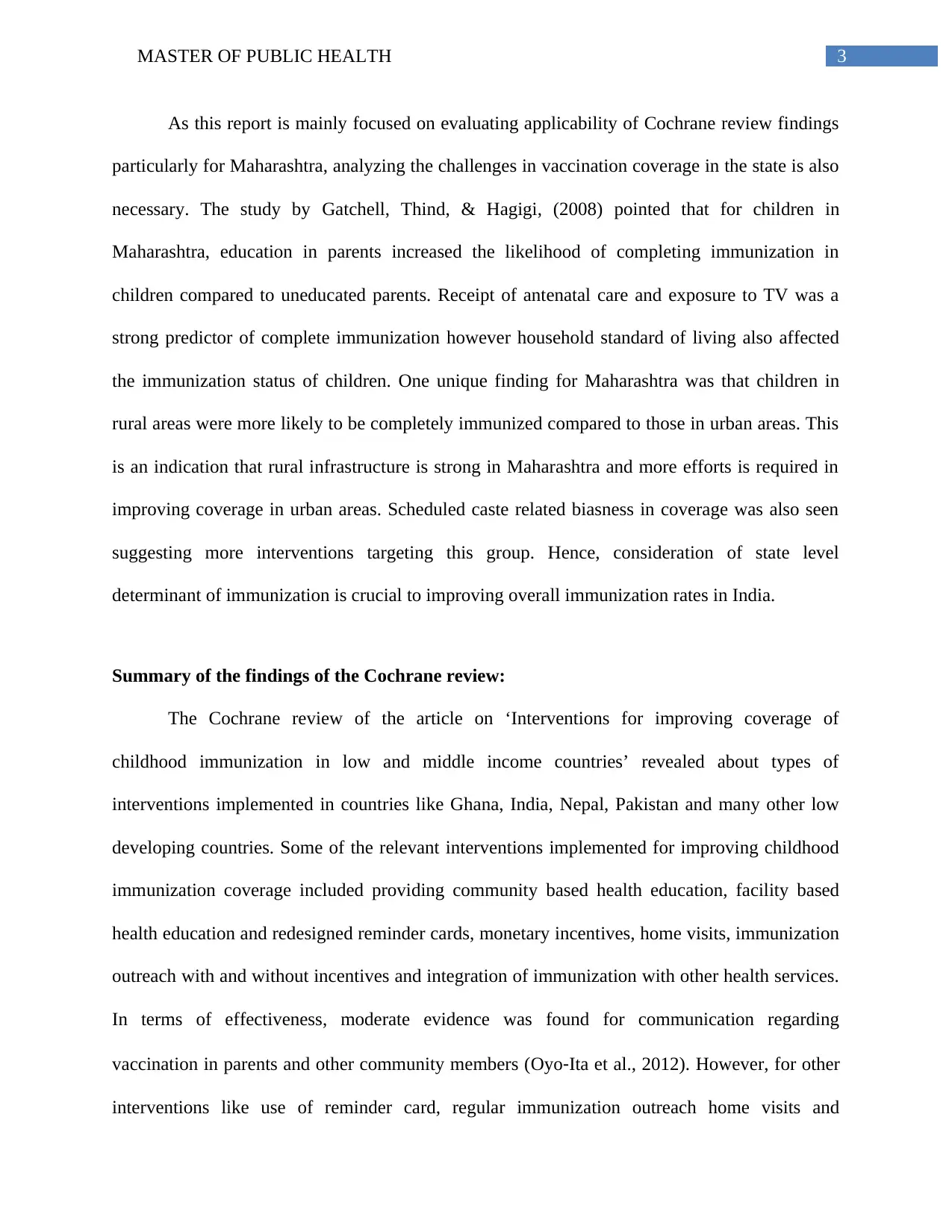
3MASTER OF PUBLIC HEALTH
As this report is mainly focused on evaluating applicability of Cochrane review findings
particularly for Maharashtra, analyzing the challenges in vaccination coverage in the state is also
necessary. The study by Gatchell, Thind, & Hagigi, (2008) pointed that for children in
Maharashtra, education in parents increased the likelihood of completing immunization in
children compared to uneducated parents. Receipt of antenatal care and exposure to TV was a
strong predictor of complete immunization however household standard of living also affected
the immunization status of children. One unique finding for Maharashtra was that children in
rural areas were more likely to be completely immunized compared to those in urban areas. This
is an indication that rural infrastructure is strong in Maharashtra and more efforts is required in
improving coverage in urban areas. Scheduled caste related biasness in coverage was also seen
suggesting more interventions targeting this group. Hence, consideration of state level
determinant of immunization is crucial to improving overall immunization rates in India.
Summary of the findings of the Cochrane review:
The Cochrane review of the article on ‘Interventions for improving coverage of
childhood immunization in low and middle income countries’ revealed about types of
interventions implemented in countries like Ghana, India, Nepal, Pakistan and many other low
developing countries. Some of the relevant interventions implemented for improving childhood
immunization coverage included providing community based health education, facility based
health education and redesigned reminder cards, monetary incentives, home visits, immunization
outreach with and without incentives and integration of immunization with other health services.
In terms of effectiveness, moderate evidence was found for communication regarding
vaccination in parents and other community members (Oyo‐Ita et al., 2012). However, for other
interventions like use of reminder card, regular immunization outreach home visits and
As this report is mainly focused on evaluating applicability of Cochrane review findings
particularly for Maharashtra, analyzing the challenges in vaccination coverage in the state is also
necessary. The study by Gatchell, Thind, & Hagigi, (2008) pointed that for children in
Maharashtra, education in parents increased the likelihood of completing immunization in
children compared to uneducated parents. Receipt of antenatal care and exposure to TV was a
strong predictor of complete immunization however household standard of living also affected
the immunization status of children. One unique finding for Maharashtra was that children in
rural areas were more likely to be completely immunized compared to those in urban areas. This
is an indication that rural infrastructure is strong in Maharashtra and more efforts is required in
improving coverage in urban areas. Scheduled caste related biasness in coverage was also seen
suggesting more interventions targeting this group. Hence, consideration of state level
determinant of immunization is crucial to improving overall immunization rates in India.
Summary of the findings of the Cochrane review:
The Cochrane review of the article on ‘Interventions for improving coverage of
childhood immunization in low and middle income countries’ revealed about types of
interventions implemented in countries like Ghana, India, Nepal, Pakistan and many other low
developing countries. Some of the relevant interventions implemented for improving childhood
immunization coverage included providing community based health education, facility based
health education and redesigned reminder cards, monetary incentives, home visits, immunization
outreach with and without incentives and integration of immunization with other health services.
In terms of effectiveness, moderate evidence was found for communication regarding
vaccination in parents and other community members (Oyo‐Ita et al., 2012). However, for other
interventions like use of reminder card, regular immunization outreach home visits and
Secure Best Marks with AI Grader
Need help grading? Try our AI Grader for instant feedback on your assignments.
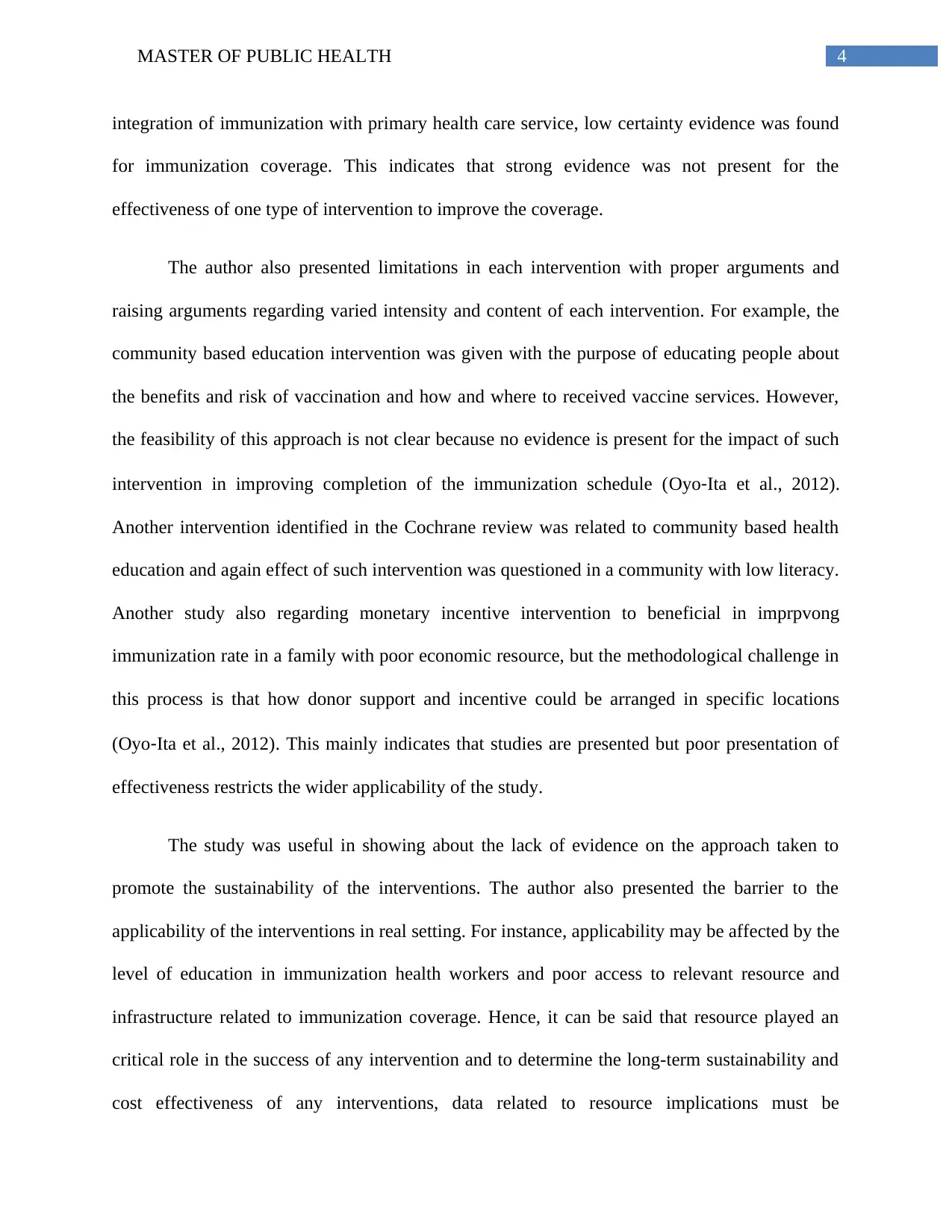
4MASTER OF PUBLIC HEALTH
integration of immunization with primary health care service, low certainty evidence was found
for immunization coverage. This indicates that strong evidence was not present for the
effectiveness of one type of intervention to improve the coverage.
The author also presented limitations in each intervention with proper arguments and
raising arguments regarding varied intensity and content of each intervention. For example, the
community based education intervention was given with the purpose of educating people about
the benefits and risk of vaccination and how and where to received vaccine services. However,
the feasibility of this approach is not clear because no evidence is present for the impact of such
intervention in improving completion of the immunization schedule (Oyo‐Ita et al., 2012).
Another intervention identified in the Cochrane review was related to community based health
education and again effect of such intervention was questioned in a community with low literacy.
Another study also regarding monetary incentive intervention to beneficial in imprpvong
immunization rate in a family with poor economic resource, but the methodological challenge in
this process is that how donor support and incentive could be arranged in specific locations
(Oyo‐Ita et al., 2012). This mainly indicates that studies are presented but poor presentation of
effectiveness restricts the wider applicability of the study.
The study was useful in showing about the lack of evidence on the approach taken to
promote the sustainability of the interventions. The author also presented the barrier to the
applicability of the interventions in real setting. For instance, applicability may be affected by the
level of education in immunization health workers and poor access to relevant resource and
infrastructure related to immunization coverage. Hence, it can be said that resource played an
critical role in the success of any intervention and to determine the long-term sustainability and
cost effectiveness of any interventions, data related to resource implications must be
integration of immunization with primary health care service, low certainty evidence was found
for immunization coverage. This indicates that strong evidence was not present for the
effectiveness of one type of intervention to improve the coverage.
The author also presented limitations in each intervention with proper arguments and
raising arguments regarding varied intensity and content of each intervention. For example, the
community based education intervention was given with the purpose of educating people about
the benefits and risk of vaccination and how and where to received vaccine services. However,
the feasibility of this approach is not clear because no evidence is present for the impact of such
intervention in improving completion of the immunization schedule (Oyo‐Ita et al., 2012).
Another intervention identified in the Cochrane review was related to community based health
education and again effect of such intervention was questioned in a community with low literacy.
Another study also regarding monetary incentive intervention to beneficial in imprpvong
immunization rate in a family with poor economic resource, but the methodological challenge in
this process is that how donor support and incentive could be arranged in specific locations
(Oyo‐Ita et al., 2012). This mainly indicates that studies are presented but poor presentation of
effectiveness restricts the wider applicability of the study.
The study was useful in showing about the lack of evidence on the approach taken to
promote the sustainability of the interventions. The author also presented the barrier to the
applicability of the interventions in real setting. For instance, applicability may be affected by the
level of education in immunization health workers and poor access to relevant resource and
infrastructure related to immunization coverage. Hence, it can be said that resource played an
critical role in the success of any intervention and to determine the long-term sustainability and
cost effectiveness of any interventions, data related to resource implications must be
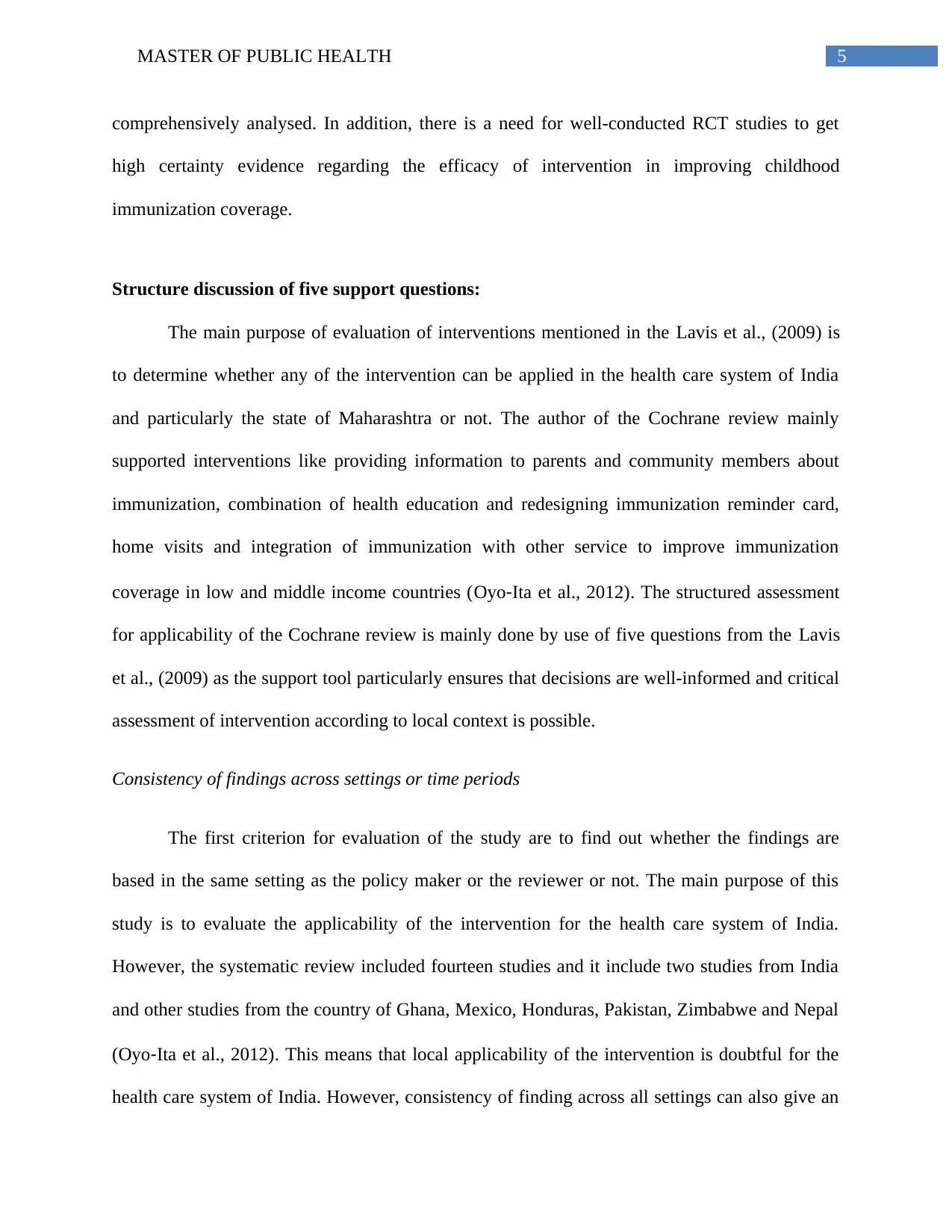
5MASTER OF PUBLIC HEALTH
comprehensively analysed. In addition, there is a need for well-conducted RCT studies to get
high certainty evidence regarding the efficacy of intervention in improving childhood
immunization coverage.
Structure discussion of five support questions:
The main purpose of evaluation of interventions mentioned in the Lavis et al., (2009) is
to determine whether any of the intervention can be applied in the health care system of India
and particularly the state of Maharashtra or not. The author of the Cochrane review mainly
supported interventions like providing information to parents and community members about
immunization, combination of health education and redesigning immunization reminder card,
home visits and integration of immunization with other service to improve immunization
coverage in low and middle income countries (Oyo‐Ita et al., 2012). The structured assessment
for applicability of the Cochrane review is mainly done by use of five questions from the Lavis
et al., (2009) as the support tool particularly ensures that decisions are well-informed and critical
assessment of intervention according to local context is possible.
Consistency of findings across settings or time periods
The first criterion for evaluation of the study are to find out whether the findings are
based in the same setting as the policy maker or the reviewer or not. The main purpose of this
study is to evaluate the applicability of the intervention for the health care system of India.
However, the systematic review included fourteen studies and it include two studies from India
and other studies from the country of Ghana, Mexico, Honduras, Pakistan, Zimbabwe and Nepal
(Oyo‐Ita et al., 2012). This means that local applicability of the intervention is doubtful for the
health care system of India. However, consistency of finding across all settings can also give an
comprehensively analysed. In addition, there is a need for well-conducted RCT studies to get
high certainty evidence regarding the efficacy of intervention in improving childhood
immunization coverage.
Structure discussion of five support questions:
The main purpose of evaluation of interventions mentioned in the Lavis et al., (2009) is
to determine whether any of the intervention can be applied in the health care system of India
and particularly the state of Maharashtra or not. The author of the Cochrane review mainly
supported interventions like providing information to parents and community members about
immunization, combination of health education and redesigning immunization reminder card,
home visits and integration of immunization with other service to improve immunization
coverage in low and middle income countries (Oyo‐Ita et al., 2012). The structured assessment
for applicability of the Cochrane review is mainly done by use of five questions from the Lavis
et al., (2009) as the support tool particularly ensures that decisions are well-informed and critical
assessment of intervention according to local context is possible.
Consistency of findings across settings or time periods
The first criterion for evaluation of the study are to find out whether the findings are
based in the same setting as the policy maker or the reviewer or not. The main purpose of this
study is to evaluate the applicability of the intervention for the health care system of India.
However, the systematic review included fourteen studies and it include two studies from India
and other studies from the country of Ghana, Mexico, Honduras, Pakistan, Zimbabwe and Nepal
(Oyo‐Ita et al., 2012). This means that local applicability of the intervention is doubtful for the
health care system of India. However, consistency of finding across all settings can also give an
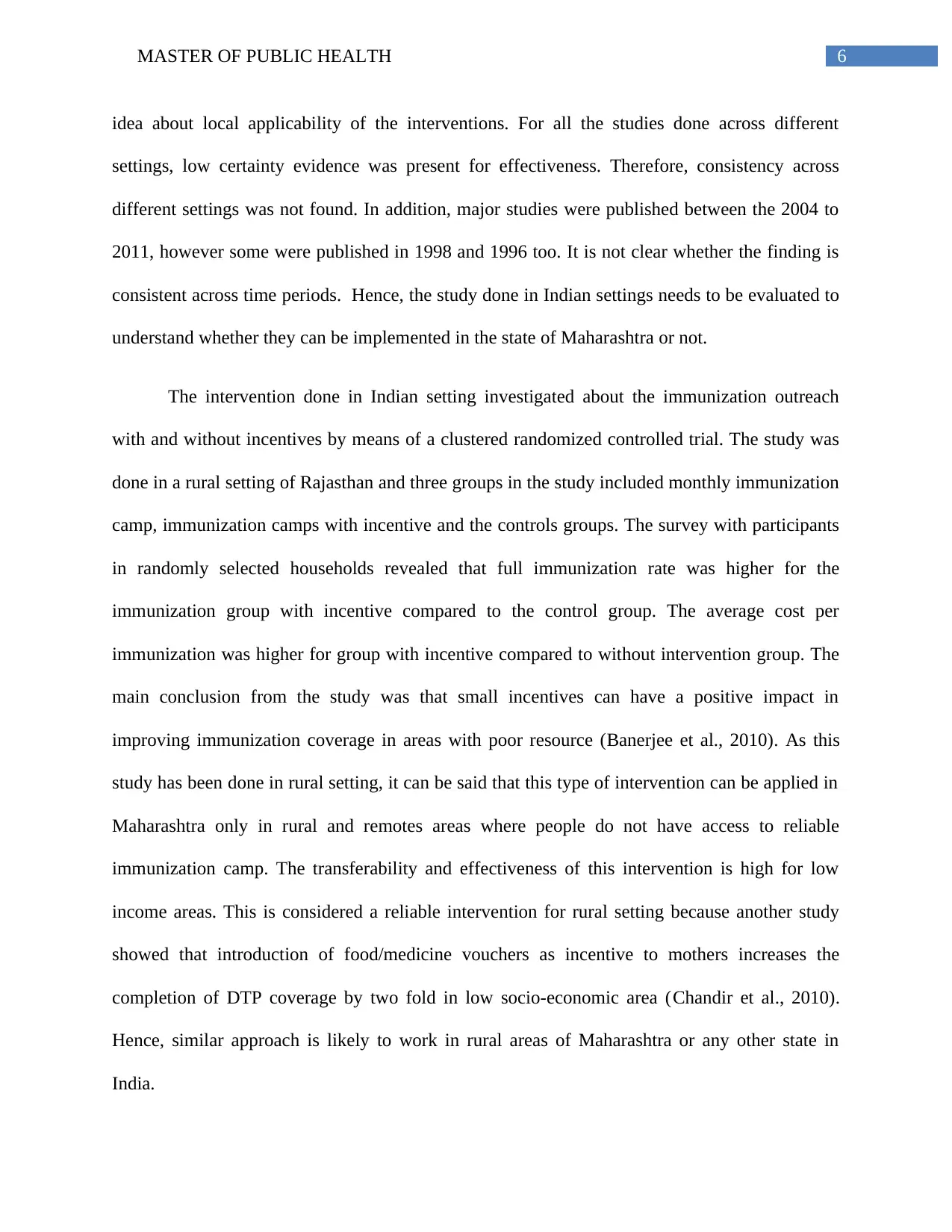
6MASTER OF PUBLIC HEALTH
idea about local applicability of the interventions. For all the studies done across different
settings, low certainty evidence was present for effectiveness. Therefore, consistency across
different settings was not found. In addition, major studies were published between the 2004 to
2011, however some were published in 1998 and 1996 too. It is not clear whether the finding is
consistent across time periods. Hence, the study done in Indian settings needs to be evaluated to
understand whether they can be implemented in the state of Maharashtra or not.
The intervention done in Indian setting investigated about the immunization outreach
with and without incentives by means of a clustered randomized controlled trial. The study was
done in a rural setting of Rajasthan and three groups in the study included monthly immunization
camp, immunization camps with incentive and the controls groups. The survey with participants
in randomly selected households revealed that full immunization rate was higher for the
immunization group with incentive compared to the control group. The average cost per
immunization was higher for group with incentive compared to without intervention group. The
main conclusion from the study was that small incentives can have a positive impact in
improving immunization coverage in areas with poor resource (Banerjee et al., 2010). As this
study has been done in rural setting, it can be said that this type of intervention can be applied in
Maharashtra only in rural and remotes areas where people do not have access to reliable
immunization camp. The transferability and effectiveness of this intervention is high for low
income areas. This is considered a reliable intervention for rural setting because another study
showed that introduction of food/medicine vouchers as incentive to mothers increases the
completion of DTP coverage by two fold in low socio-economic area (Chandir et al., 2010).
Hence, similar approach is likely to work in rural areas of Maharashtra or any other state in
India.
idea about local applicability of the interventions. For all the studies done across different
settings, low certainty evidence was present for effectiveness. Therefore, consistency across
different settings was not found. In addition, major studies were published between the 2004 to
2011, however some were published in 1998 and 1996 too. It is not clear whether the finding is
consistent across time periods. Hence, the study done in Indian settings needs to be evaluated to
understand whether they can be implemented in the state of Maharashtra or not.
The intervention done in Indian setting investigated about the immunization outreach
with and without incentives by means of a clustered randomized controlled trial. The study was
done in a rural setting of Rajasthan and three groups in the study included monthly immunization
camp, immunization camps with incentive and the controls groups. The survey with participants
in randomly selected households revealed that full immunization rate was higher for the
immunization group with incentive compared to the control group. The average cost per
immunization was higher for group with incentive compared to without intervention group. The
main conclusion from the study was that small incentives can have a positive impact in
improving immunization coverage in areas with poor resource (Banerjee et al., 2010). As this
study has been done in rural setting, it can be said that this type of intervention can be applied in
Maharashtra only in rural and remotes areas where people do not have access to reliable
immunization camp. The transferability and effectiveness of this intervention is high for low
income areas. This is considered a reliable intervention for rural setting because another study
showed that introduction of food/medicine vouchers as incentive to mothers increases the
completion of DTP coverage by two fold in low socio-economic area (Chandir et al., 2010).
Hence, similar approach is likely to work in rural areas of Maharashtra or any other state in
India.
Paraphrase This Document
Need a fresh take? Get an instant paraphrase of this document with our AI Paraphraser

7MASTER OF PUBLIC HEALTH
In the context of Maharashtra and India, immunization with incentive intervention is not
likely to be effective and reliable in urban areas. Review of studies done in other countries will
also not help to determine the applicability of any intervention for India because the health care
system of India will differ from that of other countries. The immunization service outreach urban
children may differ based on standard of living index. The review of challenges faced in
achieving immunization target in India or Maharashtra may also help in determining the most
effective intervention for urban areas. The study on trends in child immunization across
geographical regions in India has revealed that urban-rural different and gender equity in
different states has an impact on immunization coverage. In Maharashtra, particularly, the gender
equality ratio is high and gender inequality challenges in full immunization coverage needs to be
considered (Singh, 2013). Hence, this element needs to be considered in intervention for
improving coverage in Maharashtra.
Factors affecting the feasibility or acceptability of intervention options:
The systematic review proposed various interventions for improving the childhood
immunization coverage. However, their feasibility and acceptability may be affected by ground
realities and political or other constraints faced in India, hence before deciding on any
intervention for Maharashtra, the links with ground realities needs to be analysed. In terms of
ground realities, the main challenges is that health worker density is low in India and the
distribution of health workers remains a barrier to Universal Health coverage. Association has
been found between shortage of health workers and poorer health outcomes in Indian state.
Hence, if any interventions focuses on community based health educations, the shortage of
community health workers in any Indian state will reduce the applicability of the intervention.
The rural-urban division also affects immunization coverage and for rural areas of Maharashtra,
In the context of Maharashtra and India, immunization with incentive intervention is not
likely to be effective and reliable in urban areas. Review of studies done in other countries will
also not help to determine the applicability of any intervention for India because the health care
system of India will differ from that of other countries. The immunization service outreach urban
children may differ based on standard of living index. The review of challenges faced in
achieving immunization target in India or Maharashtra may also help in determining the most
effective intervention for urban areas. The study on trends in child immunization across
geographical regions in India has revealed that urban-rural different and gender equity in
different states has an impact on immunization coverage. In Maharashtra, particularly, the gender
equality ratio is high and gender inequality challenges in full immunization coverage needs to be
considered (Singh, 2013). Hence, this element needs to be considered in intervention for
improving coverage in Maharashtra.
Factors affecting the feasibility or acceptability of intervention options:
The systematic review proposed various interventions for improving the childhood
immunization coverage. However, their feasibility and acceptability may be affected by ground
realities and political or other constraints faced in India, hence before deciding on any
intervention for Maharashtra, the links with ground realities needs to be analysed. In terms of
ground realities, the main challenges is that health worker density is low in India and the
distribution of health workers remains a barrier to Universal Health coverage. Association has
been found between shortage of health workers and poorer health outcomes in Indian state.
Hence, if any interventions focuses on community based health educations, the shortage of
community health workers in any Indian state will reduce the applicability of the intervention.
The rural-urban division also affects immunization coverage and for rural areas of Maharashtra,
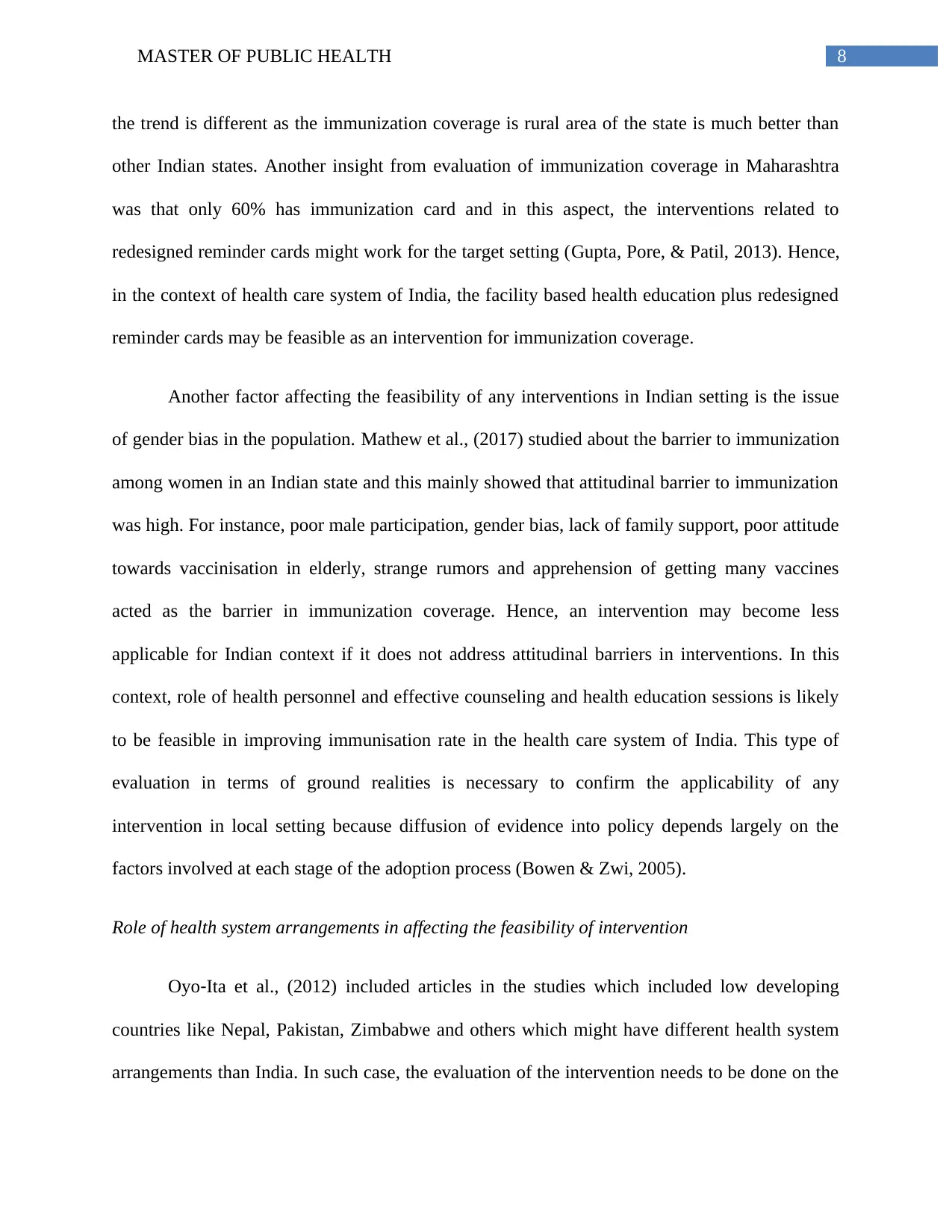
8MASTER OF PUBLIC HEALTH
the trend is different as the immunization coverage is rural area of the state is much better than
other Indian states. Another insight from evaluation of immunization coverage in Maharashtra
was that only 60% has immunization card and in this aspect, the interventions related to
redesigned reminder cards might work for the target setting (Gupta, Pore, & Patil, 2013). Hence,
in the context of health care system of India, the facility based health education plus redesigned
reminder cards may be feasible as an intervention for immunization coverage.
Another factor affecting the feasibility of any interventions in Indian setting is the issue
of gender bias in the population. Mathew et al., (2017) studied about the barrier to immunization
among women in an Indian state and this mainly showed that attitudinal barrier to immunization
was high. For instance, poor male participation, gender bias, lack of family support, poor attitude
towards vaccinisation in elderly, strange rumors and apprehension of getting many vaccines
acted as the barrier in immunization coverage. Hence, an intervention may become less
applicable for Indian context if it does not address attitudinal barriers in interventions. In this
context, role of health personnel and effective counseling and health education sessions is likely
to be feasible in improving immunisation rate in the health care system of India. This type of
evaluation in terms of ground realities is necessary to confirm the applicability of any
intervention in local setting because diffusion of evidence into policy depends largely on the
factors involved at each stage of the adoption process (Bowen & Zwi, 2005).
Role of health system arrangements in affecting the feasibility of intervention
Oyo‐Ita et al., (2012) included articles in the studies which included low developing
countries like Nepal, Pakistan, Zimbabwe and others which might have different health system
arrangements than India. In such case, the evaluation of the intervention needs to be done on the
the trend is different as the immunization coverage is rural area of the state is much better than
other Indian states. Another insight from evaluation of immunization coverage in Maharashtra
was that only 60% has immunization card and in this aspect, the interventions related to
redesigned reminder cards might work for the target setting (Gupta, Pore, & Patil, 2013). Hence,
in the context of health care system of India, the facility based health education plus redesigned
reminder cards may be feasible as an intervention for immunization coverage.
Another factor affecting the feasibility of any interventions in Indian setting is the issue
of gender bias in the population. Mathew et al., (2017) studied about the barrier to immunization
among women in an Indian state and this mainly showed that attitudinal barrier to immunization
was high. For instance, poor male participation, gender bias, lack of family support, poor attitude
towards vaccinisation in elderly, strange rumors and apprehension of getting many vaccines
acted as the barrier in immunization coverage. Hence, an intervention may become less
applicable for Indian context if it does not address attitudinal barriers in interventions. In this
context, role of health personnel and effective counseling and health education sessions is likely
to be feasible in improving immunisation rate in the health care system of India. This type of
evaluation in terms of ground realities is necessary to confirm the applicability of any
intervention in local setting because diffusion of evidence into policy depends largely on the
factors involved at each stage of the adoption process (Bowen & Zwi, 2005).
Role of health system arrangements in affecting the feasibility of intervention
Oyo‐Ita et al., (2012) included articles in the studies which included low developing
countries like Nepal, Pakistan, Zimbabwe and others which might have different health system
arrangements than India. In such case, the evaluation of the intervention needs to be done on the
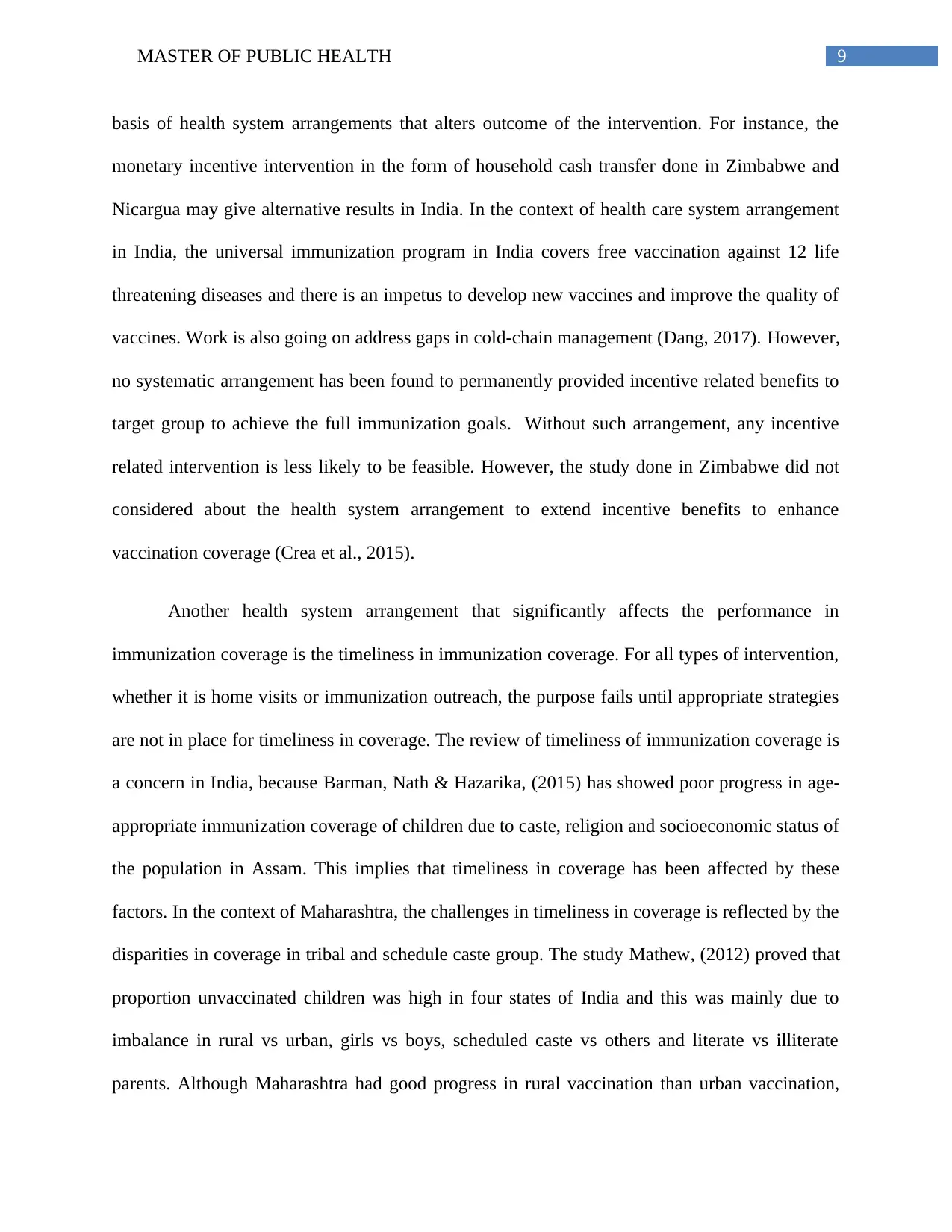
9MASTER OF PUBLIC HEALTH
basis of health system arrangements that alters outcome of the intervention. For instance, the
monetary incentive intervention in the form of household cash transfer done in Zimbabwe and
Nicargua may give alternative results in India. In the context of health care system arrangement
in India, the universal immunization program in India covers free vaccination against 12 life
threatening diseases and there is an impetus to develop new vaccines and improve the quality of
vaccines. Work is also going on address gaps in cold-chain management (Dang, 2017). However,
no systematic arrangement has been found to permanently provided incentive related benefits to
target group to achieve the full immunization goals. Without such arrangement, any incentive
related intervention is less likely to be feasible. However, the study done in Zimbabwe did not
considered about the health system arrangement to extend incentive benefits to enhance
vaccination coverage (Crea et al., 2015).
Another health system arrangement that significantly affects the performance in
immunization coverage is the timeliness in immunization coverage. For all types of intervention,
whether it is home visits or immunization outreach, the purpose fails until appropriate strategies
are not in place for timeliness in coverage. The review of timeliness of immunization coverage is
a concern in India, because Barman, Nath & Hazarika, (2015) has showed poor progress in age-
appropriate immunization coverage of children due to caste, religion and socioeconomic status of
the population in Assam. This implies that timeliness in coverage has been affected by these
factors. In the context of Maharashtra, the challenges in timeliness in coverage is reflected by the
disparities in coverage in tribal and schedule caste group. The study Mathew, (2012) proved that
proportion unvaccinated children was high in four states of India and this was mainly due to
imbalance in rural vs urban, girls vs boys, scheduled caste vs others and literate vs illiterate
parents. Although Maharashtra had good progress in rural vaccination than urban vaccination,
basis of health system arrangements that alters outcome of the intervention. For instance, the
monetary incentive intervention in the form of household cash transfer done in Zimbabwe and
Nicargua may give alternative results in India. In the context of health care system arrangement
in India, the universal immunization program in India covers free vaccination against 12 life
threatening diseases and there is an impetus to develop new vaccines and improve the quality of
vaccines. Work is also going on address gaps in cold-chain management (Dang, 2017). However,
no systematic arrangement has been found to permanently provided incentive related benefits to
target group to achieve the full immunization goals. Without such arrangement, any incentive
related intervention is less likely to be feasible. However, the study done in Zimbabwe did not
considered about the health system arrangement to extend incentive benefits to enhance
vaccination coverage (Crea et al., 2015).
Another health system arrangement that significantly affects the performance in
immunization coverage is the timeliness in immunization coverage. For all types of intervention,
whether it is home visits or immunization outreach, the purpose fails until appropriate strategies
are not in place for timeliness in coverage. The review of timeliness of immunization coverage is
a concern in India, because Barman, Nath & Hazarika, (2015) has showed poor progress in age-
appropriate immunization coverage of children due to caste, religion and socioeconomic status of
the population in Assam. This implies that timeliness in coverage has been affected by these
factors. In the context of Maharashtra, the challenges in timeliness in coverage is reflected by the
disparities in coverage in tribal and schedule caste group. The study Mathew, (2012) proved that
proportion unvaccinated children was high in four states of India and this was mainly due to
imbalance in rural vs urban, girls vs boys, scheduled caste vs others and literate vs illiterate
parents. Although Maharashtra had good progress in rural vaccination than urban vaccination,
Secure Best Marks with AI Grader
Need help grading? Try our AI Grader for instant feedback on your assignments.

10MASTER OF PUBLIC HEALTH
but lower complete vaccination was found in families belong to scheduled caste in the state. This
means different in social characteristics of Maharashtra is likely to affect the feasibility of any
intervention.
Difference in baseline considerations:
The baseline conditions in any study is also likely to give idea about the effectiveness of
interventions. The study included in the systematic review can be evaluated for feasibility in
Maharashtra, India by analyzing the relation between baseline conditions and absolute effects.
The review of characteristics of included studies has shown that baseline condition was not
similar to those of Maharashtra, India in all case. For example, there was an article that focused
on evidence based discussion on immunization in poorest districts of countries (Andersson et al.,
2009) and another study focused on disadvantage rural community in India for vaccination
coverage (Banerjee et al., 2013). However, this is not applicable for the state of Maharashtra
because improving immunization rate in rural areas is not their priority. Statistics reveals that
immunization rate for rural areas in Maharashtra are good because of good rural infrastructure.
Hence, interventions focusing on rural areas stand irrelevant for brining improvement in the
context of Maharashtra, India.
Review of studies of cash transfer gave idea about impact of intervention on eligible
village community and the education component. This again is not feasible for the baseline
condition of Maharashtra (Oyo‐Ita et al., 2012). However, on intervention is found to have
greater baseline similarity to that of Maharashtra state as it aimed to address immunization
coverage in spite of developed immunization infrastructure by means of home visit. This is
relevant to the target state because despite the good immunization infrastructure, the state has not
but lower complete vaccination was found in families belong to scheduled caste in the state. This
means different in social characteristics of Maharashtra is likely to affect the feasibility of any
intervention.
Difference in baseline considerations:
The baseline conditions in any study is also likely to give idea about the effectiveness of
interventions. The study included in the systematic review can be evaluated for feasibility in
Maharashtra, India by analyzing the relation between baseline conditions and absolute effects.
The review of characteristics of included studies has shown that baseline condition was not
similar to those of Maharashtra, India in all case. For example, there was an article that focused
on evidence based discussion on immunization in poorest districts of countries (Andersson et al.,
2009) and another study focused on disadvantage rural community in India for vaccination
coverage (Banerjee et al., 2013). However, this is not applicable for the state of Maharashtra
because improving immunization rate in rural areas is not their priority. Statistics reveals that
immunization rate for rural areas in Maharashtra are good because of good rural infrastructure.
Hence, interventions focusing on rural areas stand irrelevant for brining improvement in the
context of Maharashtra, India.
Review of studies of cash transfer gave idea about impact of intervention on eligible
village community and the education component. This again is not feasible for the baseline
condition of Maharashtra (Oyo‐Ita et al., 2012). However, on intervention is found to have
greater baseline similarity to that of Maharashtra state as it aimed to address immunization
coverage in spite of developed immunization infrastructure by means of home visit. This is
relevant to the target state because despite the good immunization infrastructure, the state has not
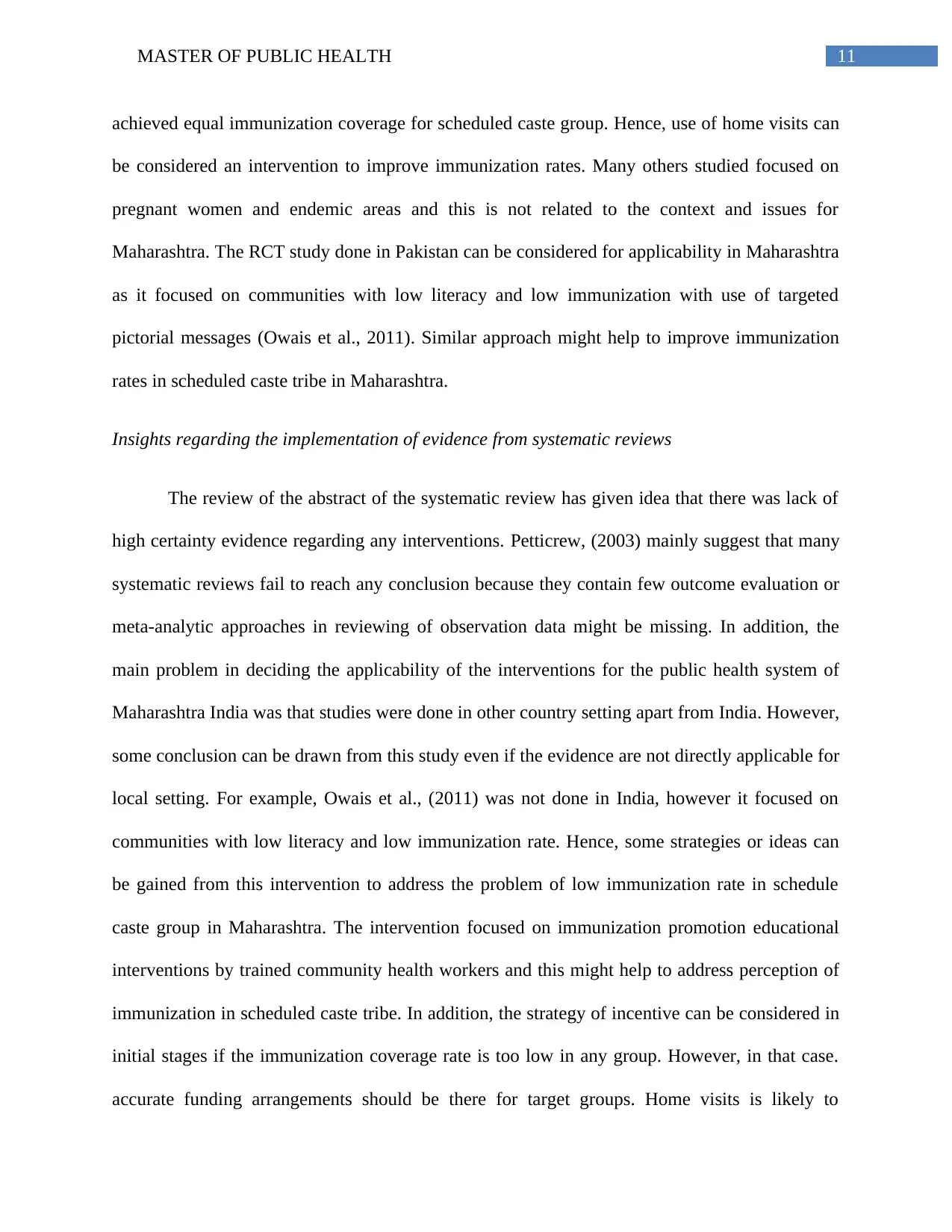
11MASTER OF PUBLIC HEALTH
achieved equal immunization coverage for scheduled caste group. Hence, use of home visits can
be considered an intervention to improve immunization rates. Many others studied focused on
pregnant women and endemic areas and this is not related to the context and issues for
Maharashtra. The RCT study done in Pakistan can be considered for applicability in Maharashtra
as it focused on communities with low literacy and low immunization with use of targeted
pictorial messages (Owais et al., 2011). Similar approach might help to improve immunization
rates in scheduled caste tribe in Maharashtra.
Insights regarding the implementation of evidence from systematic reviews
The review of the abstract of the systematic review has given idea that there was lack of
high certainty evidence regarding any interventions. Petticrew, (2003) mainly suggest that many
systematic reviews fail to reach any conclusion because they contain few outcome evaluation or
meta-analytic approaches in reviewing of observation data might be missing. In addition, the
main problem in deciding the applicability of the interventions for the public health system of
Maharashtra India was that studies were done in other country setting apart from India. However,
some conclusion can be drawn from this study even if the evidence are not directly applicable for
local setting. For example, Owais et al., (2011) was not done in India, however it focused on
communities with low literacy and low immunization rate. Hence, some strategies or ideas can
be gained from this intervention to address the problem of low immunization rate in schedule
caste group in Maharashtra. The intervention focused on immunization promotion educational
interventions by trained community health workers and this might help to address perception of
immunization in scheduled caste tribe. In addition, the strategy of incentive can be considered in
initial stages if the immunization coverage rate is too low in any group. However, in that case.
accurate funding arrangements should be there for target groups. Home visits is likely to
achieved equal immunization coverage for scheduled caste group. Hence, use of home visits can
be considered an intervention to improve immunization rates. Many others studied focused on
pregnant women and endemic areas and this is not related to the context and issues for
Maharashtra. The RCT study done in Pakistan can be considered for applicability in Maharashtra
as it focused on communities with low literacy and low immunization with use of targeted
pictorial messages (Owais et al., 2011). Similar approach might help to improve immunization
rates in scheduled caste tribe in Maharashtra.
Insights regarding the implementation of evidence from systematic reviews
The review of the abstract of the systematic review has given idea that there was lack of
high certainty evidence regarding any interventions. Petticrew, (2003) mainly suggest that many
systematic reviews fail to reach any conclusion because they contain few outcome evaluation or
meta-analytic approaches in reviewing of observation data might be missing. In addition, the
main problem in deciding the applicability of the interventions for the public health system of
Maharashtra India was that studies were done in other country setting apart from India. However,
some conclusion can be drawn from this study even if the evidence are not directly applicable for
local setting. For example, Owais et al., (2011) was not done in India, however it focused on
communities with low literacy and low immunization rate. Hence, some strategies or ideas can
be gained from this intervention to address the problem of low immunization rate in schedule
caste group in Maharashtra. The intervention focused on immunization promotion educational
interventions by trained community health workers and this might help to address perception of
immunization in scheduled caste tribe. In addition, the strategy of incentive can be considered in
initial stages if the immunization coverage rate is too low in any group. However, in that case.
accurate funding arrangements should be there for target groups. Home visits is likely to
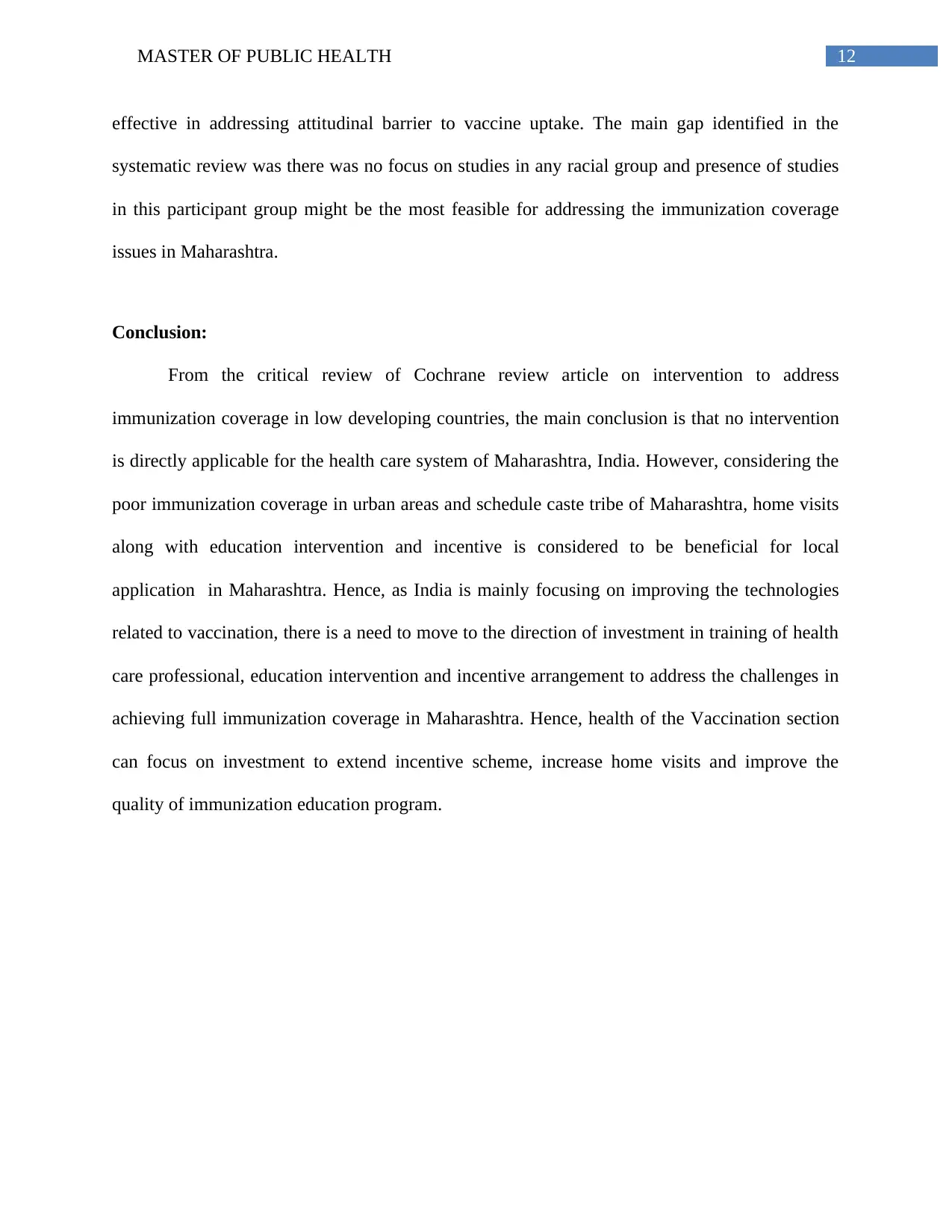
12MASTER OF PUBLIC HEALTH
effective in addressing attitudinal barrier to vaccine uptake. The main gap identified in the
systematic review was there was no focus on studies in any racial group and presence of studies
in this participant group might be the most feasible for addressing the immunization coverage
issues in Maharashtra.
Conclusion:
From the critical review of Cochrane review article on intervention to address
immunization coverage in low developing countries, the main conclusion is that no intervention
is directly applicable for the health care system of Maharashtra, India. However, considering the
poor immunization coverage in urban areas and schedule caste tribe of Maharashtra, home visits
along with education intervention and incentive is considered to be beneficial for local
application in Maharashtra. Hence, as India is mainly focusing on improving the technologies
related to vaccination, there is a need to move to the direction of investment in training of health
care professional, education intervention and incentive arrangement to address the challenges in
achieving full immunization coverage in Maharashtra. Hence, health of the Vaccination section
can focus on investment to extend incentive scheme, increase home visits and improve the
quality of immunization education program.
effective in addressing attitudinal barrier to vaccine uptake. The main gap identified in the
systematic review was there was no focus on studies in any racial group and presence of studies
in this participant group might be the most feasible for addressing the immunization coverage
issues in Maharashtra.
Conclusion:
From the critical review of Cochrane review article on intervention to address
immunization coverage in low developing countries, the main conclusion is that no intervention
is directly applicable for the health care system of Maharashtra, India. However, considering the
poor immunization coverage in urban areas and schedule caste tribe of Maharashtra, home visits
along with education intervention and incentive is considered to be beneficial for local
application in Maharashtra. Hence, as India is mainly focusing on improving the technologies
related to vaccination, there is a need to move to the direction of investment in training of health
care professional, education intervention and incentive arrangement to address the challenges in
achieving full immunization coverage in Maharashtra. Hence, health of the Vaccination section
can focus on investment to extend incentive scheme, increase home visits and improve the
quality of immunization education program.
Paraphrase This Document
Need a fresh take? Get an instant paraphrase of this document with our AI Paraphraser

13MASTER OF PUBLIC HEALTH
Reference
Andersson, N., Cockcroft, A., Ansari, N. M., Omer, K., Baloch, M., Foster, A. H., ... &
Soberanis, J. L. (2009). Evidence-based discussion increases childhood vaccination
uptake: a randomised cluster controlled trial of knowledge translation in Pakistan. BMC
International Health and Human Rights, 9(1), S8.
Banerjee, A. V., Duflo, E., Glennerster, R., & Kothari, D. (2010). Improving immunisation
coverage in rural India: clustered randomised controlled evaluation of immunisation
campaigns with and without incentives. Bmj, 340, c2220.
Barman, M. P., Nath, K., & Hazarika, J. (2015). Factors Affecting Timeliness of Immunization
Coverage Among Children of Assam, India: A Cross-sectional Study. Journal of Health
Management, 17(3), 274-284.
Bhatnagar, P., Gupta, S., Kumar, R., Haldar, P., Sethi, R., & Bahl, S. (2016). Estimation of child
vaccination coverage at state and national levels in India. Bulletin of the World Health
Organization, 94(10), 728.
Bowen, S., & Zwi, A. B. (2005). Pathways to “evidence-informed” policy and practice: a
framework for action. PLoS medicine, 2(7), e166.
https://doi.org/10.1371/journal.pmed.0020166
Centre for Public Impact. (2017). The Universal Immunisation Programme in India - Centre for
Public Impact. [online] Available at:
https://www.centreforpublicimpact.org/case-study/universal-immunization-program-
india/ [Accessed 11 Oct. 2017].
Reference
Andersson, N., Cockcroft, A., Ansari, N. M., Omer, K., Baloch, M., Foster, A. H., ... &
Soberanis, J. L. (2009). Evidence-based discussion increases childhood vaccination
uptake: a randomised cluster controlled trial of knowledge translation in Pakistan. BMC
International Health and Human Rights, 9(1), S8.
Banerjee, A. V., Duflo, E., Glennerster, R., & Kothari, D. (2010). Improving immunisation
coverage in rural India: clustered randomised controlled evaluation of immunisation
campaigns with and without incentives. Bmj, 340, c2220.
Barman, M. P., Nath, K., & Hazarika, J. (2015). Factors Affecting Timeliness of Immunization
Coverage Among Children of Assam, India: A Cross-sectional Study. Journal of Health
Management, 17(3), 274-284.
Bhatnagar, P., Gupta, S., Kumar, R., Haldar, P., Sethi, R., & Bahl, S. (2016). Estimation of child
vaccination coverage at state and national levels in India. Bulletin of the World Health
Organization, 94(10), 728.
Bowen, S., & Zwi, A. B. (2005). Pathways to “evidence-informed” policy and practice: a
framework for action. PLoS medicine, 2(7), e166.
https://doi.org/10.1371/journal.pmed.0020166
Centre for Public Impact. (2017). The Universal Immunisation Programme in India - Centre for
Public Impact. [online] Available at:
https://www.centreforpublicimpact.org/case-study/universal-immunization-program-
india/ [Accessed 11 Oct. 2017].

14MASTER OF PUBLIC HEALTH
Chandir, S., Khan, A. J., Hussain, H., Usman, H. R., Khowaja, S., Halsey, N. A., & Omer, S. B.
(2010). Effect of food coupon incentives on timely completion of DTP immunization
series in children from a low-income area in Karachi, Pakistan: a longitudinal
intervention study. Vaccine, 28(19), 3473-3478.
Crea, T. M., Reynolds, A. D., Sinha, A., Eaton, J. W., Robertson, L. A., Mushati, P., ... &
Nyamukapa, C. A. (2015). Effects of cash transfers on Children’s health and social
protection in Sub-Saharan Africa: differences in outcomes based on orphan status and
household assets. BMC public health, 15(1), 511.
Dang, N. (2017). Vaccines: An investment in health for a better tomorrow. Retrieved 13 October
2017, from http://www.hindustantimes.com/opinion/vaccines-an-investment-in-health-
for-a-better-tomorrow/story-AtOtSP73YXaJCxRmdXnffL.html
EPI Fact Sheet. (2017). Searo.who.int. [online] Available at:
http://www.searo.who.int/entity/immunization/data/india.pdf?ua=1 [Accessed 11 Oct.
2017].
Gatchell, M., Thind, A., & Hagigi, F. (2008). Informing state‐level health policy in India: The
case of childhood immunizations in Maharashtra and Bihar. Acta Pædiatrica, 97(1), 124-
126.
Gupta, P. K., Pore, P., & Patil, U. (2013). Evaluation of immunization coverage in the rural area
of Pune, Maharashtra, using the 30 cluster sampling technique. Journal of family
medicine and primary care, 2(1), 50.
Chandir, S., Khan, A. J., Hussain, H., Usman, H. R., Khowaja, S., Halsey, N. A., & Omer, S. B.
(2010). Effect of food coupon incentives on timely completion of DTP immunization
series in children from a low-income area in Karachi, Pakistan: a longitudinal
intervention study. Vaccine, 28(19), 3473-3478.
Crea, T. M., Reynolds, A. D., Sinha, A., Eaton, J. W., Robertson, L. A., Mushati, P., ... &
Nyamukapa, C. A. (2015). Effects of cash transfers on Children’s health and social
protection in Sub-Saharan Africa: differences in outcomes based on orphan status and
household assets. BMC public health, 15(1), 511.
Dang, N. (2017). Vaccines: An investment in health for a better tomorrow. Retrieved 13 October
2017, from http://www.hindustantimes.com/opinion/vaccines-an-investment-in-health-
for-a-better-tomorrow/story-AtOtSP73YXaJCxRmdXnffL.html
EPI Fact Sheet. (2017). Searo.who.int. [online] Available at:
http://www.searo.who.int/entity/immunization/data/india.pdf?ua=1 [Accessed 11 Oct.
2017].
Gatchell, M., Thind, A., & Hagigi, F. (2008). Informing state‐level health policy in India: The
case of childhood immunizations in Maharashtra and Bihar. Acta Pædiatrica, 97(1), 124-
126.
Gupta, P. K., Pore, P., & Patil, U. (2013). Evaluation of immunization coverage in the rural area
of Pune, Maharashtra, using the 30 cluster sampling technique. Journal of family
medicine and primary care, 2(1), 50.

15MASTER OF PUBLIC HEALTH
Lavis, J. N., Oxman, A. D., Souza, N. M., Lewin, S., Gruen, R. L., & Fretheim, A. (2009).
SUPPORT Tools for evidence-informed health Policymaking (STP) 9: Assessing the
applicability of the findings of a systematic review. Health Research Policy and
Systems, 7(1), S9.
Mathew, G., Johnson, A. R., Thimmaiah, S., Kumari, R., & Varghese, A. (2017). Barriers to
childhood immunisation among women in an urban underprivileged area of Bangalore
city, Karnataka, India: a qualitative study. International Journal Of Community Medicine
And Public Health, 3(6), 1525-1530.
Mathew, J. L. (2012). Inequity in childhood immunization in India: a systematic review. Indian
pediatrics, 49(3), 203-223.
Nath, L., Kaur, P., & Tripathi, S. (2015). Evaluation of the Universal Immunization Program and
Challenges in Coverage of Migrant Children in Haridwar, Uttarakhand, India. Indian
journal of community medicine: official publication of Indian Association of Preventive
& Social Medicine, 40(4), 239-245.
Owais, A., Hanif, B., Siddiqui, A. R., Agha, A., & Zaidi, A. K. (2011). Does improving maternal
knowledge of vaccines impact infant immunization rates? A community-based
randomized-controlled trial in Karachi, Pakistan. BMC public health, 11(1), 239.
Oyo‐Ita, A., Nwachukwu, C. E., Oringanje, C., & Meremikwu, M. M. (2012). Cochrane Review:
Interventions for improving coverage of child immunization in low‐and middle‐income
countries. Evidence
‐Based Child Health: A Cochrane Review Journal, 7(3), 959-1012.
Lavis, J. N., Oxman, A. D., Souza, N. M., Lewin, S., Gruen, R. L., & Fretheim, A. (2009).
SUPPORT Tools for evidence-informed health Policymaking (STP) 9: Assessing the
applicability of the findings of a systematic review. Health Research Policy and
Systems, 7(1), S9.
Mathew, G., Johnson, A. R., Thimmaiah, S., Kumari, R., & Varghese, A. (2017). Barriers to
childhood immunisation among women in an urban underprivileged area of Bangalore
city, Karnataka, India: a qualitative study. International Journal Of Community Medicine
And Public Health, 3(6), 1525-1530.
Mathew, J. L. (2012). Inequity in childhood immunization in India: a systematic review. Indian
pediatrics, 49(3), 203-223.
Nath, L., Kaur, P., & Tripathi, S. (2015). Evaluation of the Universal Immunization Program and
Challenges in Coverage of Migrant Children in Haridwar, Uttarakhand, India. Indian
journal of community medicine: official publication of Indian Association of Preventive
& Social Medicine, 40(4), 239-245.
Owais, A., Hanif, B., Siddiqui, A. R., Agha, A., & Zaidi, A. K. (2011). Does improving maternal
knowledge of vaccines impact infant immunization rates? A community-based
randomized-controlled trial in Karachi, Pakistan. BMC public health, 11(1), 239.
Oyo‐Ita, A., Nwachukwu, C. E., Oringanje, C., & Meremikwu, M. M. (2012). Cochrane Review:
Interventions for improving coverage of child immunization in low‐and middle‐income
countries. Evidence
‐Based Child Health: A Cochrane Review Journal, 7(3), 959-1012.
Secure Best Marks with AI Grader
Need help grading? Try our AI Grader for instant feedback on your assignments.
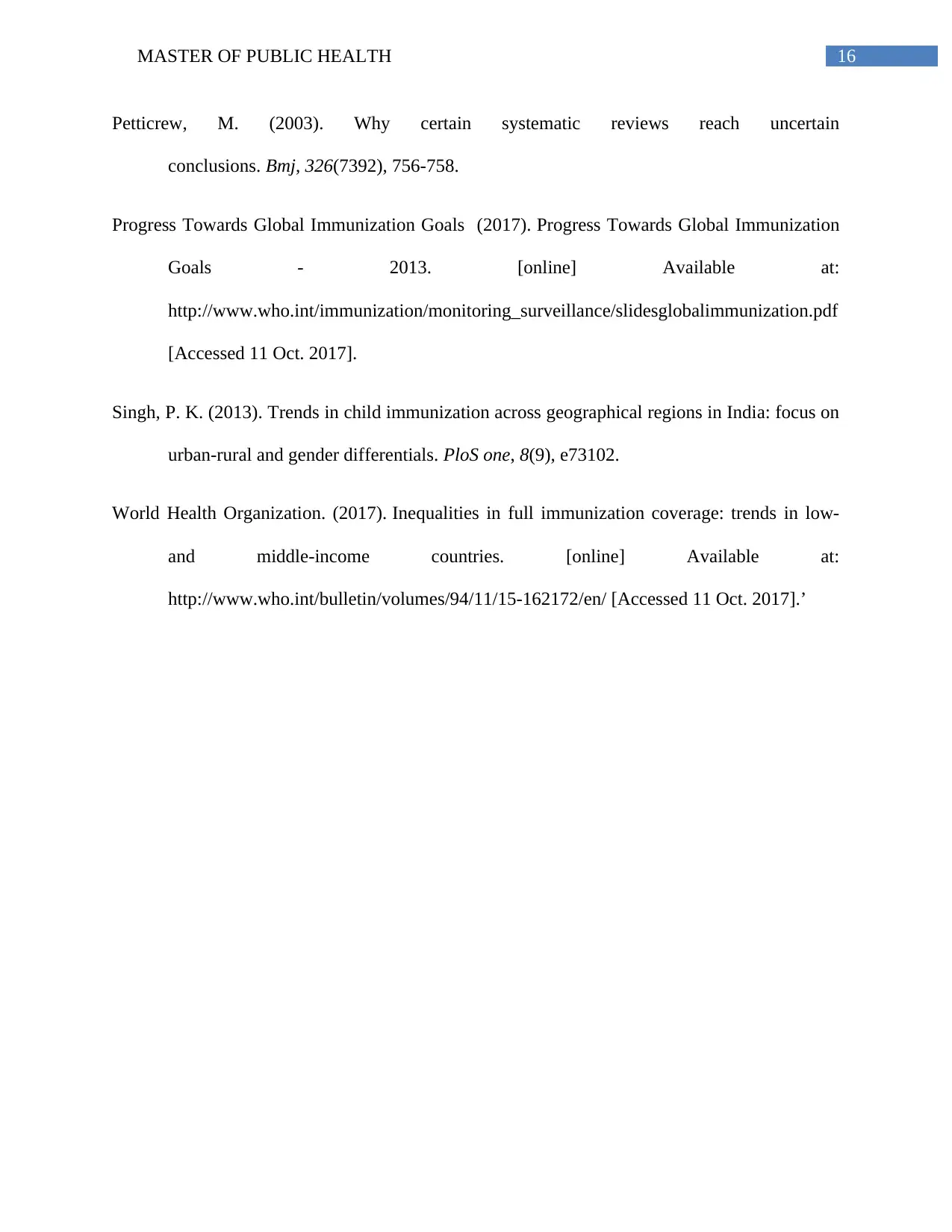
16MASTER OF PUBLIC HEALTH
Petticrew, M. (2003). Why certain systematic reviews reach uncertain
conclusions. Bmj, 326(7392), 756-758.
Progress Towards Global Immunization Goals (2017). Progress Towards Global Immunization
Goals - 2013. [online] Available at:
http://www.who.int/immunization/monitoring_surveillance/slidesglobalimmunization.pdf
[Accessed 11 Oct. 2017].
Singh, P. K. (2013). Trends in child immunization across geographical regions in India: focus on
urban-rural and gender differentials. PloS one, 8(9), e73102.
World Health Organization. (2017). Inequalities in full immunization coverage: trends in low-
and middle-income countries. [online] Available at:
http://www.who.int/bulletin/volumes/94/11/15-162172/en/ [Accessed 11 Oct. 2017].’
Petticrew, M. (2003). Why certain systematic reviews reach uncertain
conclusions. Bmj, 326(7392), 756-758.
Progress Towards Global Immunization Goals (2017). Progress Towards Global Immunization
Goals - 2013. [online] Available at:
http://www.who.int/immunization/monitoring_surveillance/slidesglobalimmunization.pdf
[Accessed 11 Oct. 2017].
Singh, P. K. (2013). Trends in child immunization across geographical regions in India: focus on
urban-rural and gender differentials. PloS one, 8(9), e73102.
World Health Organization. (2017). Inequalities in full immunization coverage: trends in low-
and middle-income countries. [online] Available at:
http://www.who.int/bulletin/volumes/94/11/15-162172/en/ [Accessed 11 Oct. 2017].’
1 out of 17
Related Documents
Your All-in-One AI-Powered Toolkit for Academic Success.
+13062052269
info@desklib.com
Available 24*7 on WhatsApp / Email
![[object Object]](/_next/static/media/star-bottom.7253800d.svg)
Unlock your academic potential
© 2024 | Zucol Services PVT LTD | All rights reserved.
